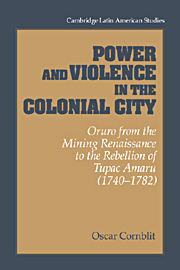 Power and Violence in the Colonial City
Power and Violence in the Colonial City Book contents
- Frontmatter
- Contents
- List of figure, maps, and tables
- Preface
- Map 1 Present-day Bolivia and surrounds
- Map 2 Principal routes of the Viceroyalty of Peru (second half of the eighteenth century)
- 1 Oruro between two epochs: a mining cycle
- 2 Under Spanish law
- 3 Oruro in 1741: details of a stormy election
- 4 The people
- 5 “Madmen, comedians, and hypocrites”
- 6 Captains of shipwreck
- 7 Returning to the known
- 8 “The fruits of the earth”
- 9 The end of an epoch: the Indian uprisings of 1780–1781
- 10 Oruro in the economic and geopolitical context of the epoch (c. 1780–1781)
- 11 The Oruro uprising
- 12 The voice of the rebels
- 13 Picking up the pieces
- Appendix A Indian raids on Oruro, 1781: testimonies
- Appendix B Testimonies of inhabitants of the city
- Appendix C Table of public jobs in Oruro, 1730–1784
- Bibliography
- Index
- CAMBRIDGE LATIN AMERICAN STUDIES
13 - Picking up the pieces
Published online by Cambridge University Press: 30 March 2010
- Frontmatter
- Contents
- List of figure, maps, and tables
- Preface
- Map 1 Present-day Bolivia and surrounds
- Map 2 Principal routes of the Viceroyalty of Peru (second half of the eighteenth century)
- 1 Oruro between two epochs: a mining cycle
- 2 Under Spanish law
- 3 Oruro in 1741: details of a stormy election
- 4 The people
- 5 “Madmen, comedians, and hypocrites”
- 6 Captains of shipwreck
- 7 Returning to the known
- 8 “The fruits of the earth”
- 9 The end of an epoch: the Indian uprisings of 1780–1781
- 10 Oruro in the economic and geopolitical context of the epoch (c. 1780–1781)
- 11 The Oruro uprising
- 12 The voice of the rebels
- 13 Picking up the pieces
- Appendix A Indian raids on Oruro, 1781: testimonies
- Appendix B Testimonies of inhabitants of the city
- Appendix C Table of public jobs in Oruro, 1730–1784
- Bibliography
- Index
- CAMBRIDGE LATIN AMERICAN STUDIES
Summary
The last Indian assaults on Oruro took place in April 1781. After a day of desperate combat on April 2 in which Creoles and chapetones (only eighteen of them, according to the chronicle) fought together to defeat 120 Indians, the latter “began to beg for mercy, promising to hand over the ones who were the cause of their revolt, and many of these were also being brought daily from the towns of Sorata, Challacollo, and Poopó and their environs.”
Jacinto Rodríguez and the Oruro militia leaders reached an agreement at this point with some of the chieftains, on condition that the Indian blockade be lifted. The rebels from Paria and Sillota did not concur, however, and continued to block the road, a situation that had become equally intolerable for the businesses of Cochabamba, Oruro's traditional supplier. On Palm Sunday, just a few days after this confrontation, Commander José de Ayarza, leader of the Cochabamba militia, invaded Oruro. He had just quelled the Indian uprisings in Colcha and Quirquiabi and his troops were leading a sizable herd of livestock that they had taken from the rebels.
With this booty, he entered the city, presumably expecting a triumphal welcome from its inhabitants. This was not forthcoming, however; they were received coolly by Jacinto Rodríguez's followers, who were afraid their own authority would be undermined by the troops. Ayarza did not seem too concerned about their lack of courtesy and decided to stay in Oruro with his men until the following Tuesday. In spite of their early departure, word that they had come to the aid of Oruro spread among the Indians, finally intimidating those who insisted on enforcing the blockade.
- Type
- Chapter
- Information
- Power and Violence in the Colonial CityOruro from the Mining Renaissance to the Rebellion of Tupac Amaru (1740–1782), pp. 167 - 172Publisher: Cambridge University PressPrint publication year: 1995


